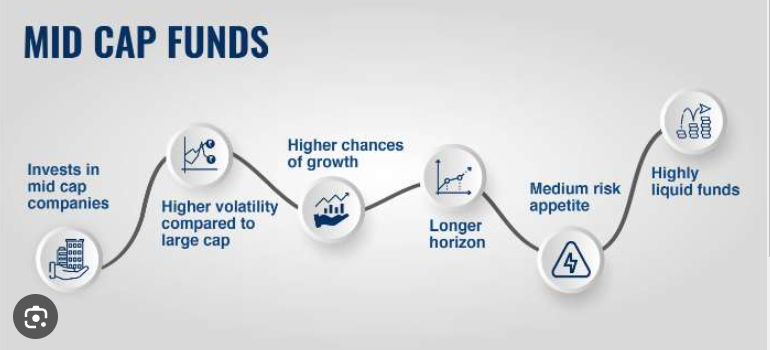Mid-Cap Fund & Why Should You Invest In Them?

Mutual funds have won immense popularity due to potential asset diversification, professional control. Among the various categories, Mid Cap Funds stand out as a compelling preference for the ones searching for a balance of potential and control. In this comprehensive manual, we will delve into the nuances of Mid Cap Funds, exploring what units them apart, their blessings, and why you need to consider incorporating them into your investment portfolio.
Table of Contents
Defining the Mid-Cap
To understand Mid Cap Funds, it’s crucial to first grasp the concept of marketplace capitalization. Market capitalization, is the whole fee of a corporation’s awesome shares of inventory. The stock marketplace normally classifies organizations into three essential classes based on their marketplace cap: large-cap, mid-cap, and small-cap.
Mid Cap Funds includes companies with a marketplace capitalization among that of big-cap and small-cap organizations. While there may be no strict definition, mid-cap agencies regularly fall in the variety of $2 billion to $10 billion in market cap. Nowadays, you can easily invest in mid cap and other mutual funds through an online trading platform. Most platforms nowadays allow you to access a variety of financial instruments apart from the facility to invest in stocks.
Why Mid Cap Funds?
Balancing Growth and Risk
Investing in Mid Cap Funds gives a unique blend of boom potential and hazard control. Unlike massive-cap corporations that could have already skilled sizable growth or small-cap agencies nonetheless establishing themselves, mid-cap companies are located for growth, innovation, and multiplied marketplace percentage.
Growth Potential
Mid-cap groups, being in a segment of energetic boom, can exhibit higher sales and profits boom compared to their larger opposite numbers. As those organizations extend and faucet into new markets, their stocks have the capability for full-size capital appreciation.
Diversification
Diversification is a fundamental principle of sound funding strategy. Mid Cap Funds provide an possibility to diversify your portfolio past large-cap and small-cap shares. By spreading your investments throughout exclusive marketplace segments, you can lessen the effect of negative performance in any single category, improving the overall balance of your portfolio.
Risk Management
While mid-cap shares may be more volatile than their large-cap opposite numbers, they generally carry less risk than small-cap shares. Mid-cap businesses have frequently verified a diploma of stability in their operations, that may mitigate some of the risks associated with making an investment in smaller, less set up businesses. As a end result, Mid Cap Funds offer a balanced risk-reward profile.
Types of Mid-Cap Funds
Understanding the Varieties
Mid Cap Funds come in various sorts, catering to one-of-a-kind investor options and hazard appetites. Here are some commonplace forms of Mid Cap Funds:
Actively Managed Mid Cap Funds
These funds are actively controlled with the aid of expert fund managers who make strategic choices on stock selection and portfolio allocation. The purpose is to outperform the marketplace and deliver above-common returns. Actively managed Mid Cap Funds regularly contain higher management prices, reflecting the knowledge and studies concerning the energetic management technique.
Passively Managed Mid Cap Funds (Index Funds and ETFs)
Passively controlled Mid Cap Funds goal to copy the performance of a selected market index, along with the S&P MidCap four hundred. These budgets typically have decreased cost ratios as compared to actively managed price ranges due to the fact they require less ongoing management. Index budget and change-traded finances (ETFs) are famous alternatives for investors in search of a value-effective manner to benefit publicity to the mid-cap section.
Value-Oriented Mid Cap Funds
Value-oriented Mid Cap Funds cognizance on organizations which can be taken into consideration as undervalued primarily based on fundamental evaluation. Fund managers in these price range are looking for stocks with decrease-than-predicted valuations, aiming for capacity capital appreciation as the marketplace acknowledges the authentic cost of those corporations.
Growth-Oriented Mid Cap Funds
Growth-oriented Mid Cap Funds, however, target agencies with sturdy growth potentialities. Fund managers on this class may additionally prioritize stocks with higher profits boom and revenue growth ability. These funds are suitable for investors seeking out capital appreciation thru exposure to companies in the mid-cap area with strong growth trajectories.
Key Considerations for Investing in Mid-Cap Funds
Before incorporating Mid Cap Funds into your investment approach, don’t forget the subsequent elements:
Risk Tolerance
Assess your hazard tolerance to determine if Mid Cap Funds align along with your funding targets. While they provide boom capacity, mid-cap stocks can enjoy better volatility than huge-cap stocks. Understanding your consolation stage with market fluctuations is essential in making knowledgeable investment selections.
Investment Horizon
Your funding horizon performs a vital function in selecting the right price range. Mid-Cap Funds can be greater appropriate for investors with a medium to lengthy-time period investment horizon. The boom ability of mid-cap shares can also take time to materialize, and short-term fluctuations may also impact returns.
Diversification Needs
Evaluate your present portfolio to determine if Mid Cap Funds can make contributions to higher diversification. A nicely assorted portfolio that spans unique market segments can beautify ordinary balance and reduce the impact of terrible performance in any single category.
Expense Ratios
Consider the price ratios related to Mid Cap Funds. Actively managed funds may additionally have higher cost ratios due to the energetic management involved, even as passively managed finances (index budget and ETFs) normally have decreased charges. Factor in these charges whilst evaluating the overall suitability of the fund in your investment method. You can also invest in mutual funds through a Demat Account app. Several platforms now offer all kinds of investment facilities including mutual funds on a single app.
Conclusion
Mid Cap Funds emerge as a strategic choice in the diverse realm of investment options, offering a balanced blend of growth potential and risk management. Positioned between large-cap stability and small-cap innovation, mid-cap companies within these funds present investors with opportunities for substantial capital appreciation. The advantages include diversification beyond conventional stocks, effective risk mitigation compared to small-cap investments, and the prospect of riding the growth wave of dynamic enterprises. Understanding the types and key considerations is important to appropriately invest in Mid Cap Funds judiciously.


